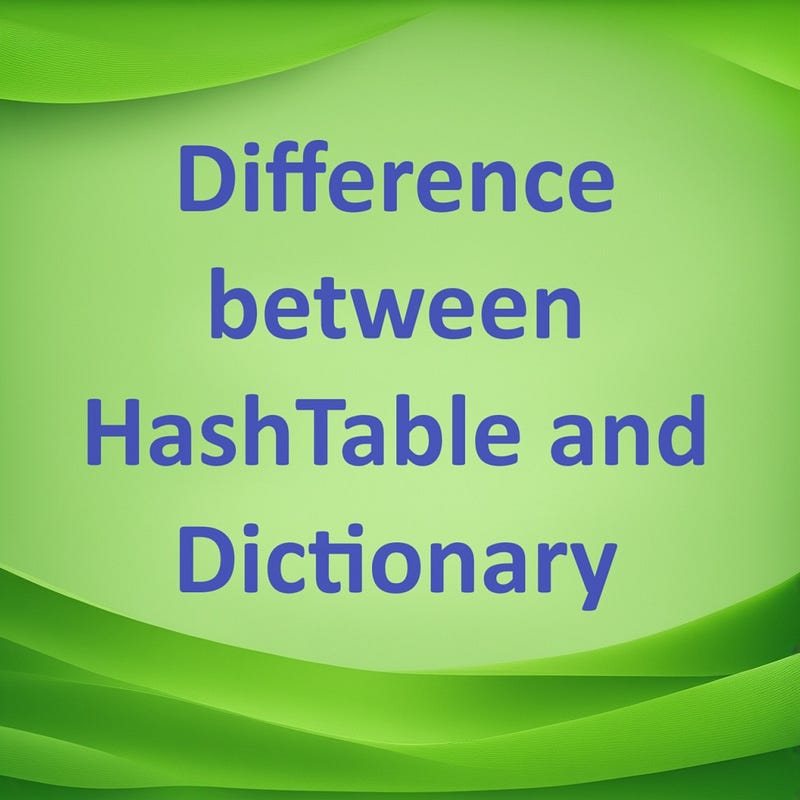Understanding the Differences Between HashTable and Dictionary in C#
Written on
Chapter 1: Overview of HashTable and Dictionary
In C#, the HashTable and Dictionary collections serve as tools for storing key-value pairs, but they belong to different namespaces and offer distinct functionalities. The HashTable is part of the System.Collections namespace, allowing for the storage of key-value pairs of any data type, such as integers, floats, or strings. On the other hand, Dictionary is found in the System.Collections.Generic namespace and is designed to hold key-value pairs of a specified data type.

Section 1.1: Characteristics of HashTable
- Thread Safety: HashTable is not inherently thread-safe. When multiple threads access a HashTable simultaneously, and at least one thread modifies it, external synchronization is necessary.
- Null Keys and Values: HashTable permits both null keys and values, meaning that if a key is null, no exception is thrown.
- Performance: As an older collection in .NET, HashTable generally performs less efficiently than newer collections like Dictionary, which utilize hashing to find elements based on their keys.
- Type Safety: HashTable lacks type safety, treating all keys and values as objects. This necessitates type casting when retrieving values.
- Obsolescence in Modern Code: With the introduction of generics in C# 2.0, HashTable has fallen out of favor, often being replaced by more type-safe alternatives.
using System;
using System.Collections;
public class Program
{
public static void Main(string[] args)
{
Hashtable fruittable = new Hashtable();
// HashTable can store various data types including string, integer, and double
fruittable.Add("FruitName", "Apple");
fruittable.Add("FruitPrice", 20);
fruittable.Add("FruitWeight", "11.28");
foreach (DictionaryEntry entry in fruittable)
{
Console.WriteLine($"{entry.Key}: {entry.Value}");}
}
}
Output
FruitPrice: 20
FruitName: Apple
FruitWeight: 11.28
Section 1.2: Characteristics of Dictionary
- Thread Safety: Like HashTable, Dictionary is not inherently thread-safe. It requires external synchronization when multiple threads access it concurrently.
- Null Keys and Values: Unlike HashTable, Dictionary does not allow null keys or values. Attempting to add either will result in an exception.
- Performance: Dictionary typically outperforms HashTable, particularly in scenarios where type safety is crucial, as it avoids the overhead associated with casting.
- Type Safety: As a generic collection, Dictionary is type-safe. It allows the specification of key and value types during collection definition, ensuring compile-time type checking.
- Generics Support: Dictionary is part of the generic collections introduced in C# 2.0, enabling more efficient and type-safe coding practices.
using System;
using System.Collections.Generic;
public class Program
{
public static void Main(string[] args)
{
Dictionary<string, int> dictfruitprices = new Dictionary<string, int>();
Dictionary<string, string> dictfruitnames = new Dictionary<string, string>();
// Dictionary can store specific data types like integer and string
dictfruitprices.Add("Apple", 16);
dictfruitprices.Add("Mango", 12);
dictfruitnames.Add("Apple", "Red");
dictfruitnames.Add("Mango", "Yellow");
foreach (var fruitprice in dictfruitprices)
{
Console.WriteLine($"{fruitprice.Key}: {fruitprice.Value}");}
foreach (var fruitcolor in dictfruitnames)
{
Console.WriteLine($"{fruitcolor.Key}: {fruitcolor.Value}");}
}
}
Output
Apple: 16
Mango: 12
Apple: Red
Mango: Yellow
Chapter 2: When to Use Each Collection
Use HashTable When:
- You are maintaining legacy code or frameworks that utilize HashTable.
- Thread safety is not a concern, or you manage it externally.
- You need to allow null keys or values.
Use Dictionary When:
- You are developing modern applications and seek a more type-safe and efficient alternative.
- Thread safety is not a concern, or you manage it externally.
- You want to enforce the use of non-null keys and values.
Conclusion
In summary, the HashTable is associated with the System.Collections namespace and can store key-value pairs of any data type. Conversely, the Dictionary, found in the System.Collections.Generic namespace, is meant for key-value pairs of specific data types.
Thank you for reading! For more insightful tutorials, please visit C-Sharp Tutorial. If you found this article helpful, please consider clapping and following the author.